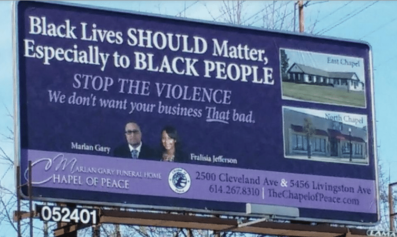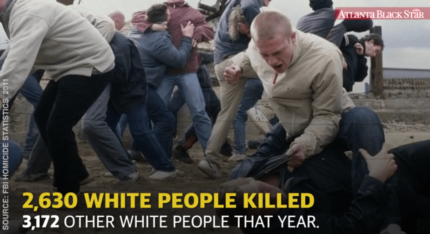In America, more frequently than any other race of people, white people kill white people. In fact, Caucasians have a lengthy history of victimizing and killing one another in their communities and, in 2014, of the 3021 murders of Caucasians nationwide, Federal Bureau of Investigation statistics report 2488 of the offenders were white. As is customarily the case, white-on-white crime — murder, in particular—dominates federal statistics every year.
That same year, of the 2451 murders of African-Americans, 2205 were committed by Black offenders. In other words, in 2014, an African-American was killed by a member of the same race 90 percent of the time while a white person was killed by a member of the same race 82 percent of the time, a difference of eight percentage points. This eight percentage point margin has pretty much remained constant for the past four decades.
Given this relatively small difference, and the consistent recognition that people victimize and murder those closest to them both racially and residentially, it begs the question why so much attention has been paid to the issue of “Black-on-Black crime.” Tellingly, a July 2017 Harvard-Harris Poll reported 70 percent of voters said black-on-black crime in African-American communities is a bigger issue than police violence against African-Americans. Twelve percent of the poll’s respondents were Black.
So, here in 2017, why is there so much focus on this popular notion of Black-on-Black crime? And how did such a construct come about in the first place?
“The term, Black-on-Black violence, comes from a sunken place,” offers Georgetown University law professor and former federal prosecutor Paul Butler. A featured legal commentator for CNN, MSNBC and NPR, Butler is author of the recently released, “Chokehold: Policing Black Men.” “It is a way of pathologizing Black people and making it seem like we’re different from everybody else.” Upon acknowledging that intraracial crime is the norm, Butler points out, “White people don’t go around being afraid of other white people, yet they’re afraid of Black men or ‘thugs’ when they are much more likely to be victimized by other white folks.”
“But we don’t have an expression called ‘white on white crime,” continues Butler, clarifying, “that’s why I say that Black-on-Black crime expression comes from a sunken place, from this stereotype of Black men as thugs.”
“The term means we are focused on what Black people do to each other as a unique phenomenon,” echoes Khalil Gibran Muhammad, professor of history, race, and public policy at the Harvard Kennedy School and the Suzanne Young Murray Professor at the Radcliffe Institute for Advanced Study. Author of The “Condemnation of Blackness: Race, Crime, and the Making of Modern Urban America,” Muhammad explains the term “comes on the heels of a long history of stigmatizing Blackness as a criminal race, essentially that African-Americans have a unique heritage of and propensity to violence.” By the 1970s, continues the historian, Black-on-Black crime becomes “a way of saying that Black people are criminals, just look at what they do to themselves.”
Despite this history, some have argued this special focus on Black crime is warranted due to African-Americans’ disproportionate representation in crime statistics. African-Americans reportedly account for 13 percent of the population yet, according to the Bureau of Justice statistics, committed 52 percent of homicides recorded between 1980 and 2008. “Relative to their share of the population, African Americans commit dramatically more crime, especially violent crimes and murders, than whites do,” wrote National Review’s Patrick Brennan in 2013, in response to an article dismissing the notion of Black-on-Black crime. He noted when such a group is only one-sixth the size of white Americans and commits crimes at “shockingly disproportionate rates,” it “certainly seems like it should qualify as a ‘thing.’”
While such critiques fail to account for the role income and inequity play in the process — African-Americans are far more likely to live in impoverished communities with higher crime rates owing to a wide range of well-established historic, socioeconomic and systemic factors — Muhammad takes it a step further. He says such critics “don’t know the history, because the way to solve crime within the Black community, or among African-Americans, is no different than any other community.” Muhammad points to the current and rampant heroin and opioid abuse among white Americans and the wide range of “criminality related to that, including theft, rape and murder. For every so-called drug dealer in the hood, there are many thousands more drug dealers in rural white America, or who wear white lab coats as physicians deliberately overprescribing painkillers.”
The point being, stresses Muhammad, “we don’t talk about the solution to that crisis as a problem of ‘white-on-white crime,’ now do we? We don’t because we know the use of the Black-on-Black crime term is meant to divorce it from a social context of being a problem for all of us to being just those people’s problem.”
“Just like white people are responding to economic inequality by engaging in self-destructive forms of drug use and drug dealing, so too have African-Americans,” continues Muhammad, saying “the only group that gets labeled” with such an intraracial moniker are African-Americans as this history of stigmatization “in terms of their crime being used as an excuse for discrimination, an excuse for racial violence, and an excuse for segregation in our public school system has functioned with far greater currency as an instrument for social control than any other group.”
Though intertwined, the term, over time, perpetuated this stigma rather than created it.
The phrase “Black on Black” crime has been sourced to an August 1970 article in the Chicago Daily Defender where civil rights activist Jesse Jackson took Illinois’ and nationally elected leaders to task for their “silence and ineffectiveness in dealing with the present black-on-black crime crisis.” Incensed by the inequitable application of law enforcement in the Black community, Jackson challenged enforcement leaders to “investigate, arrest and prosecute the guilty” while exercising “equal vigor to protect the innocent.”
Then, in December, Defender columnist Warner Saunders reported being invited to speak at a seminar on “black-on-black crime.” Saunders prepared for the seminar by interviewing a local street hustler who committed crimes against other African-Americans because of proximity and his knowledge that apathetic police patrolling the Black community, unlike those in the white suburbs, would enable him to get away with it.
“We first see the actual ‘Black-on-Black crime’ term being used in the Black press in the 1970s as a way of saying that we need to stop hurting and stealing from and robbing each other, and that it used to be white people who were our enemy but, today, it is ourselves,” says Muhammad, adding “Black people were also responding to the overwhelming stereotypes that preceded them and had existed since the end of slavery.”
By 1972, the term had gone mainstream as the popular Chicago Tribune joined the discussion of intraracial crime in the Black community and noted African-American psychiatrist Alvin F. Poussaint published the book, “Why Blacks Kill Blacks.” Soon after, wrote CityLab’s Brentin Mock in 2015, “the tone of the conversation began to shift, from black writers chastising white officials for neglecting black victims of crime in black neighborhoods, to direct chastising of black communities themselves.” Consistently, in November 1973, a strongly-worded editorial in Ebony magazine gave notice such Black-on-Black crime “will no longer be suffered in silence.”
“In the midst of, essentially, the early days of the ‘War on Crime’ and Richard Nixon’s ‘Law and Order’ campaign,” says Muhammad, “overwhelmingly white policymakers were essentially saying that Black people themselves are admitting they have a crime problem and the best response to preventing crime and saving Black lives is to beef up our criminal justice apparatus.” In other words, he says, “The law and order rhetoric used the Black-on-Black crime myth” as a way of placing blame and justifying increased police spending while “saying that we are also helping Black people too.”
Seven years later — amidst growing urban poverty and crime, white flight from urban centers, increasingly segregated communities, and an affiliated disincentivization and reluctance by cities to maintain quality services — the NAACP passed a resolution at its 1980 annual convention in Miami highlighting, among other things, the need for the criminal justice system to “recognize that crimes committed by blacks — against blacks — are as unlawful, are as humanly devastating, and are as undesirable in our black communities as crimes committed by blacks upon whites, or any group.” The increasingly intolerant tone of the language employed by the country’s most established civil rights organization gave further license to those looking to twist or co-opt its intentions and attribute culpability to the community itself.
It’s a practice in full effect today as President Donald Trump and Attorney General Jeff Sessions seek draconian measures to criminalize and over-incarcerate the drug problem in largely-Black urban centers yet simultaneously declare a national crisis for the mostly-white opioid epidemic, including planned emergency funds for widespread treatment, expanded facilities and the training and supplying of police officers with anti-overdose remedies.
After acknowledging how Black social ills are commonly criminalized and stigmatized while large-scale white problems are deemed a matter of “public health”—his book, “Chokehold,” contains numerous and representative statistics — Butler drives home the impact of such a racially-skewed national lens.
“When we think Black-on-Black, but we don’t think white-on-white, it causes people to feel like the problem is with Black men themselves,” says Butler. He suggests a substantial portion of Americans likely believe “that if they would just pull up their pants and stop calling each other ‘nigga,’ then it would be all good. And if they would just do the right thing, then they wouldn’t have to worry about being shot by police.”
Of the numerous things the expression does, contends Butler, Black-on-Black crime “provides white people, in particular, absolution. It says that it’s not an issue they have to worry about, or can do anything about anyway, because it’s a problem that Black men have.” Therefore, “We don’t look at it as a public health issue, and we don’t look at it as a national emergency,” continues Butler. “We look at it as thugs wilding out.”


